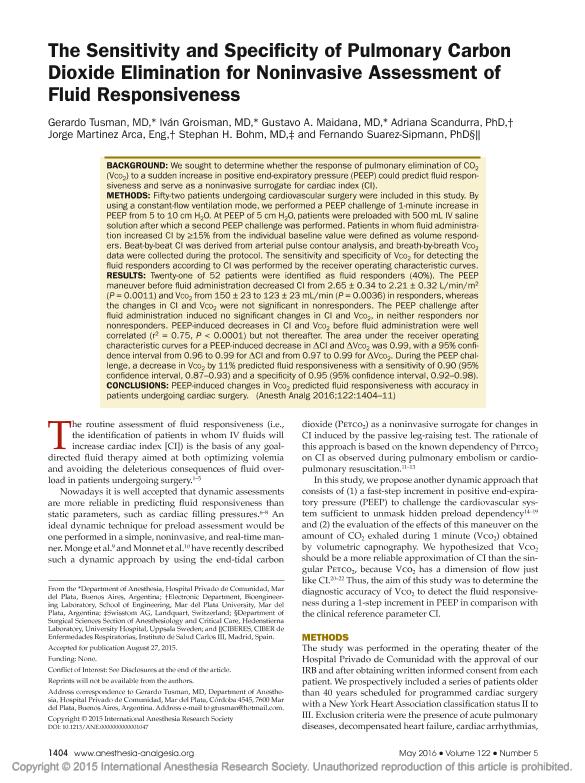Mostrar el registro sencillo del ítem
dc.contributor.author
Tusman, Gerardo
dc.contributor.author
Groisman, Ivan
dc.contributor.author
Maidana, Gustavo A.
dc.contributor.author
Scandurra, Adriana G.
dc.contributor.author
Martinez Arca, Jorge

dc.contributor.author
Bohm, Stephan H.
dc.contributor.author
Suarez-Sipmann, Fernando
dc.date.available
2018-01-15T14:56:30Z
dc.date.issued
2016-05-01
dc.identifier.citation
Tusman, Gerardo; Scandurra, Adriana G.; Maidana, Gustavo A.; Martinez Arca, Jorge; Suarez-Sipmann, Fernando; Groisman, Ivan; et al.; The sensitivity and specificity of pulmonary carbon dioxide elimination for noninvasive assessment of fluid responsiveness; Lippincott Williams; Anesthesia And Analgesia; 122; 5; 1-5-2016; 1404-1411
dc.identifier.issn
0003-2999
dc.identifier.uri
http://hdl.handle.net/11336/33214
dc.description.abstract
BACKGROUND: We sought to determine whether the response of pulmonary elimination of CO2 (Vco2) to a sudden increase in positive end-expiratory pressure (PEEP) could predict fluid responsiveness and serve as a noninvasive surrogate for cardiac index (CI).METHODS: Fifty-two patients undergoing cardiovascular surgery were included in this study. By using a constant-flow ventilation mode, we performed a PEEP challenge of 1-minute increase in PEEP from 5 to 10 cm H2O. At PEEP of 5 cm H2O, patients were preloaded with 500 mL IV salinesolution after which a second PEEP challenge was performed. Patients in whom fluid administration increased CI by ≥15% from the individual baseline value were defined as volume responders.Beat-by-beat CI was derived from arterial pulse contour analysis, and breath-by-breath Vco2 data were collected during the protocol. The sensitivity and specificity of Vco2 for detecting thefluid responders according to CI was performed by the receiver operating Characteristic curves.RESULTS: Twenty-one of 52 patients were identified as fluid responders (40%). The PEEP maneuver before fluid administration decreased CI from 2.65 ± 0.34 to 2.21 ± 0.32 L/min/m2 (P = 0.0011) and Vco2 from 150 ± 23 to 123 ± 23 mL/min (P = 0.0036) in responders, whereas the changes in CI and Vco2 were not significant in nonresponders. The PEEP challenge afterfluid administration induced no significant changes in CI and Vco2, in neither responders nor nonresponders. PEEP-induced decreases in CI and Vco2 before fluid administration were well correlated (r2 = 0.75, P < 0.0001) but not thereafter. The area under the receiver operating characteristic curves for a PEEP-induced decrease in ΔCI and ΔVco2 was 0.99, with a 95% confidence interval from 0.96 to 0.99 for ΔCI and from 0.97 to 0.99 for ΔVco2. During the PEEP challenge,a decrease in Vco2 by 11% predicted fluid responsiveness with a sensitivity of 0.90 (95% confidence interval, 0.87?0.93) and a specificity of 0.95 (95% confidence interval, 0.92?0.98).CONCLUSIONS: PEEP-induced changes in Vco2 predicted fluid responsiveness with accuracy in patients undergoing cardiac surgery. (Anesth Analg 2016;122:1404?11)
dc.format
application/pdf
dc.language.iso
eng
dc.publisher
Lippincott Williams

dc.rights
info:eu-repo/semantics/openAccess
dc.rights
Atribución-NoComercial-CompartirIgual 2.5 Argentina (CC BY-NC-SA 2.5 AR)
dc.rights.uri
https://creativecommons.org/licenses/by-nc-sa/2.5/ar/
dc.subject
Sensitivity And Specificity
dc.subject
Carbon Dioxide Elimination
dc.subject
Fluid Responsiveness
dc.subject
Cardiac Index
dc.subject.classification
Medicina Critica y de Emergencia

dc.subject.classification
Medicina Clínica

dc.subject.classification
CIENCIAS MÉDICAS Y DE LA SALUD

dc.title
The sensitivity and specificity of pulmonary carbon dioxide elimination for noninvasive assessment of fluid responsiveness
dc.type
info:eu-repo/semantics/article
dc.type
info:ar-repo/semantics/artículo
dc.type
info:eu-repo/semantics/publishedVersion
dc.date.updated
2018-01-12T19:24:37Z
dc.journal.volume
122
dc.journal.number
5
dc.journal.pagination
1404-1411
dc.journal.pais
Estados Unidos

dc.journal.ciudad
Philadelphia
dc.description.fil
Fil: Tusman, Gerardo. Fundación Medica de Mar del Plata. Hospital Privado de Comunidad; Argentina
dc.description.fil
Fil: Groisman, Ivan. Fundación Medica de Mar del Plata. Hospital Privado de Comunidad; Argentina
dc.description.fil
Fil: Maidana, Gustavo A.. Fundación Medica de Mar del Plata. Hospital Privado de Comunidad; Argentina
dc.description.fil
Fil: Scandurra, Adriana G.. Universidad Nacional de Mar del Plata. Facultad de Ingeniería. Departamento de Electronica; Argentina
dc.description.fil
Fil: Martinez Arca, Jorge. Universidad Nacional de Mar del Plata. Facultad de Ingeniería. Departamento de Electronica; Argentina. Consejo Nacional de Investigaciones Científicas y Técnicas. Centro Científico Tecnológico Conicet - Mar del Plata. Instituto de Investigaciones en Ciencia y Tecnología de Materiales. Universidad Nacional de Mar del Plata. Facultad de Ingeniería. Instituto de Investigaciones en Ciencia y Tecnología de Materiales; Argentina
dc.description.fil
Fil: Bohm, Stephan H.. University Hospital; Suecia
dc.description.fil
Fil: Suarez-Sipmann, Fernando. Instituto de Salud Carlos III; España
dc.journal.title
Anesthesia And Analgesia

dc.relation.alternativeid
info:eu-repo/semantics/altIdentifier/url/https://insights.ovid.com/pubmed?pmid=26505574
dc.relation.alternativeid
info:eu-repo/semantics/altIdentifier/doi/http://dx.doi.org/10.1213/ANE.0000000000001047
Archivos asociados
